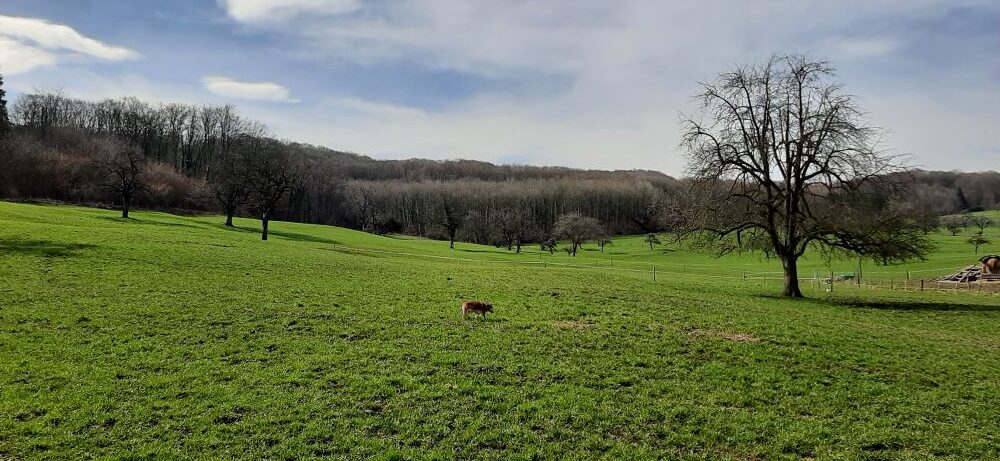Mir rede au Elsassisch, Leymen and Hagenthal-le-Bas
16 January 2024
A Swiss cartoon symbolises and puts the Röstigraben into perspective, the difference between the French and German-speaking parts of the country. On the German side of the Saane near Freiburg, a sign reads: : “Ici on parle français”. On both sides of the river, however, there are identical houses, and identically dressed people, and they eat Rösti; however, in short, they are Swiss.
The Alsatian dialect
This image comes to mind when one approaches the municipality of Leymen in Alsace, in the department of Haut-Rhin: ´Mir rede au Elsassisch´. This ancient Oberrheinalemannic dialect was the spoken language in this region (the Sundgau) of the Upper Rhine (Oberrrhein). Political developments after 1918 and 1945 pushed this dialect almost into oblivion, but it made a come-back in recent decades.
For centuries, the inhabitants of the village of Rodersdorf (canton Solothurn) communicated in this dialect with the inhabitants of the French villages of Biederthal, Leymen, Hagental-Le-Bas and Hagental-Le-Haut in the Sundgau.

Cultural trail
Therefore, the path between these French and Swiss villages is a linguistic, historical and cultural trail. Landskron Castle on the 530-metre mountain is visible from all sides, and even the Waggis of Alsace have been well-established in Basel for generations! (Fortunately, Woke did not exist back then. A Waggi is an Alsatian caricature of a peasant).

Waggis in a restaurant in Hagental-Le-Haut
This Jura landscape is also home to the sources of the Birsig river and the Strängenbach stream. The Strängenbach flows into the Birsig, and the Birsig flows through Alsace and the cantons of Solothurn and Basel-Landschaft into the Rhine in Basel in canton Basel-Stadt.
The history of these villages is closely linked to the dynasties in the neighbouring Swiss cantons and the Habsburgs. The bishop of Basel, the counts of Thierstein and Ferrette, the dynasty of Eptingen and Reich von Reichenstein (of the Landskron) were the main landowners in the area.
The area was part of the Holy Roman Empire of the German Nation and its Habsburg emperors until 1648. France acquired the Sundgau at the Peace of Westphalia 1n 1648.
Jewish community
The villages of Hagenthal-le-Bas and Hagenthal-Le-Haut (Alsace) also had a large Jewish community in the 18th century. The Jewish cemetery in Hagenthal-le-Bas is still in good condition. The cemetery in Hagenthal-Le-Haut is almost gone.

Hagenthal-Le-Haut




Hagenthal-le-Bas, Jewish cemetery
In 1784, Hagenthal-le-Bas had 356 Jewish inhabitants, Hagenthal-Le-Haut 271, almost half the inhabitants of these villages. After World War I (i.e. not because of German occupation in World War II), these communities disappeared.
Only the synagogue in rue de la Synagogue in Hagenthal-le-Bas still recalls this large Jewish community. The Jewish inhabitants of Hagenthal-le-Haut had already left the village before the First World War. The synagogue was demolished in 1903.
The reason for the flight was persecution by the local population. In 1789, the year of the French Revolution, the first pogrom took place. Many of the Jewish communities of Hagenthal-le-Bas and Hagenthal-le-Haut fled to Basel. In 1848, another year of the French Revolution, another pogrom took place.
Leymen
The village of Leymen, a few kilometres further away, lies on the border with canton Solothurn. A Franco-German language border separates these villages today, where until 1918, the Alemannic dialect was the common language.
For a long time, Leymen fell successively under the principality of Basel, the county of Ferrette and, around 1455, under the rule of the Reich von Reichenstein family. Since 1648, Leymen has been French territory.
Not only the famous castle Landskron is located in the municipality of Leymen. The village also houses two chapels. La Chapelle (the chapel) des Âmes de purgatoire was founded in 1928 for pilgrims to and from Mariastein.

The Chapel Heiligenbrunnen
According to legend, the Chapel Heiligenbrunnen is much older and was founded in the eighth century by the English or Irish monk Walburga. As the name suggests, the monk found a water spring at this place, which he used to cure a man of his blindness. An annual procession to St Walburga takes place on 1 May. The current chapel dates from 1682.

Leymen
(Source and further information: Office de Tourisme du Sundgau)

